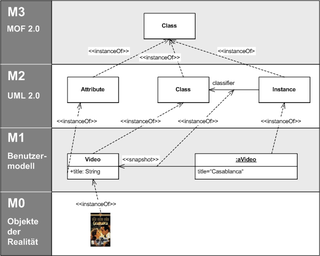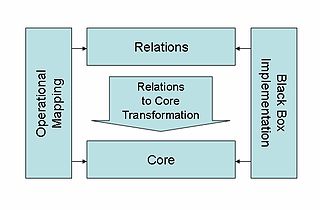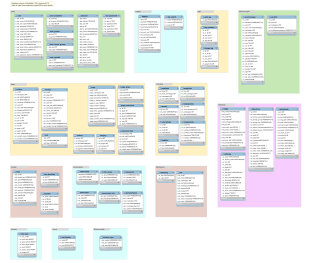Related Research Articles

An object database or object-oriented database is a database management system in which information is represented in the form of objects as used in object-oriented programming. Object databases are different from relational databases which are table-oriented. A third type, object–relational databases, is a hybrid of both approaches. Object databases have been considered since the early 1980s.
Structured Query Language (SQL) is a domain-specific language used in programming and designed for managing data held in a relational database management system (RDBMS), or for stream processing in a relational data stream management system (RDSMS). It is particularly useful in handling structured data, i.e., data incorporating relations among entities and variables.
The Common Object Request Broker Architecture (CORBA) is a standard defined by the Object Management Group (OMG) designed to facilitate the communication of systems that are deployed on diverse platforms. CORBA enables collaboration between systems on different operating systems, programming languages, and computing hardware. CORBA uses an object-oriented model although the systems that use the CORBA do not have to be object-oriented. CORBA is an example of the distributed object paradigm.
Object–relational mapping in computer science is a programming technique for converting data between a relational database and the heap of an object-oriented programming language. This creates, in effect, a virtual object database that can be used from within the programming language.

An object–relational database (ORD), or object–relational database management system (ORDBMS), is a database management system (DBMS) similar to a relational database, but with an object-oriented database model: objects, classes and inheritance are directly supported in database schemas and in the query language. In addition, just as with pure relational systems, it supports extension of the data model with custom data types and methods.

The Meta-Object Facility (MOF) is an Object Management Group (OMG) standard for model-driven engineering. Its purpose is to provide a type system for entities in the CORBA architecture and a set of interfaces through which those types can be created and manipulated. MOF may be used for domain-driven software design and object-oriented modelling.
Java Data Objects (JDO) is a specification of Java object persistence. One of its features is a transparency of the persistence services to the domain model. JDO persistent objects are ordinary Java programming language classes (POJOs); there is no requirement for them to implement certain interfaces or extend from special classes. JDO 1.0 was developed under the Java Community Process as JSR 12. JDO 2.0 was developed under JSR 243 and was released on May 10, 2006. JDO 2.1 was completed in Feb 2008, developed by the Apache JDO project. JDO 2.2 was released in October 2008. JDO 3.0 was released in April 2010.
Model Driven Architecture (MDA) is a software design approach for the development of software systems. It provides a set of guidelines for the structuring of specifications, which are expressed as models. Model Driven Architecture is a kind of domain engineering, and supports model-driven engineering of software systems. It was launched by the Object Management Group (OMG) in 2001.
The Object Constraint Language (OCL) is a declarative language describing rules applying to Unified Modeling Language (UML) models developed at IBM and is now part of the UML standard. Initially, OCL was merely a formal specification language extension for UML. OCL may now be used with any Meta-Object Facility (MOF) Object Management Group (OMG) meta-model, including UML. The Object Constraint Language is a precise text language that provides constraint and object query expressions on any MOF model or meta-model that cannot otherwise be expressed by diagrammatic notation. OCL is a key component of the new OMG standard recommendation for transforming models, the Queries/Views/Transformations (QVT) specification.
Given that metadata is a set of descriptive, structural and administrative data about a group of computer data, Java Metadata Interface is a platform-neutral specification that defines the creation, storage, access, lookup and exchange of metadata in the Java programming language.
The Data Distribution Service (DDS) for real-time systems is an Object Management Group (OMG) machine-to-machine standard that aims to enable dependable, high-performance, interoperable, real-time, scalable data exchanges using a publish–subscribe pattern.

QVT (Query/View/Transformation) is a standard set of languages for model transformation defined by the Object Management Group.
Jakarta PersistenceAPI is a Jakarta EE application programming interface specification that describes the management of relational data in enterprise Java applications.
Objectivity/DB is a commercial object database produced by Objectivity, Inc. It allows applications to make standard C++, C#, Java, or Python objects persistent without having to convert the data objects into the rows and columns used by a relational database management system (RDBMS). Objectivity/DB supports the most popular object oriented languages plus SQL/ODBC and XML. It runs on Linux, Macintosh, UNIX and Windows platforms. All of the languages and platforms interoperate, with the Objectivity/DB kernel taking care of compiler and hardware platform differences.

A database model is a type of data model that determines the logical structure of a database. It fundamentally determines in which manner data can be stored, organized and manipulated. The most popular example of a database model is the relational model, which uses a table-based format.
.QL is an object-oriented query language used to retrieve data from relational database management systems. It is reminiscent of the standard query language SQL and the object-oriented programming language Java. .QL is an object-oriented variant of a logical query language called Datalog. Hierarchical data can therefore be naturally queried in .QL in a recursive manner.
Object-oriented programming (OOP) is a programming paradigm based on the concept of objects, which can contain data and code. The data is in the form of fields, and the code is in the form of procedures.
ODABA is a terminology-oriented database management system, which is a conceptual extension of an object-oriented database system, and implements concepts defined in a terminology model. ODABA supports typical standards and technologies for object-oriented databases, but also terminology-oriented database extensions. ODABA also behaves like an object–relational database management system, i.e. data is seen as being stored in a database rather than accessing persistent objects in a programming environment. ODABA supports active data link (ADL) and provides an ADL-based GUI frame work.
Web IDL is an interface description language (IDL) format for describing application programming interfaces (APIs) that are intended to be implemented in web browsers. Its adoption was motivated by the desire to improve the interoperability of web programming interfaces by specifying how languages such as ECMAScript should bind these interfaces.
Oracle TopLink is a mapping and persistence framework for Java developers. TopLink is produced by Oracle and is a part of Oracle's OracleAS, WebLogic, and OC4J servers. It is an object-persistence and object-transformation framework. TopLink provides development tools and run-time functionalities that ease the development process and help increase functionality. Persistent object-oriented data is stored in relational databases which helps build high-performance applications. Storing data in either XML or relational databases is made possible by transforming it from object-oriented data.
References
- ^ The Object Data Standard: ODMG 3.0. Edited by R.G.G. Cattell and Douglas K. Barry, with contributions by Mark Berler, Jeff Eastman, David Jordan, Craig L. Russell, Olaf Schadow, Torsten Stanienda, and Fernando Velez. Morgan Kaufmann Publishers, Inc., 2000. ISBN 1-55860-647-5.
- ^ Object Storage Fact Books: Object DBMSs and Object–Relational Mapping. Douglas K. Barry and Joshua Duhl. Barry & Associates, Inc., 2001. Pages showing the ODMG compliance for both object database and object–relational mapping products in 2001.